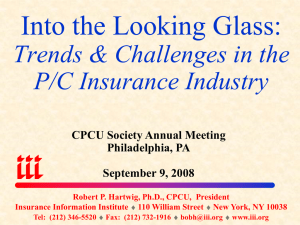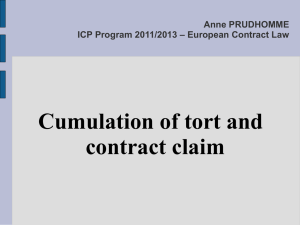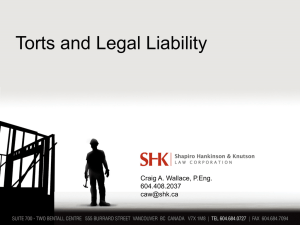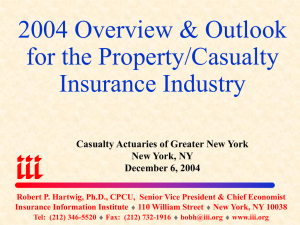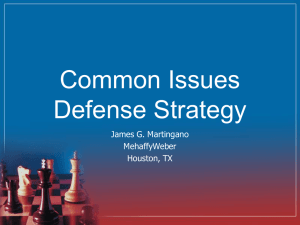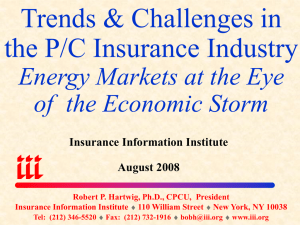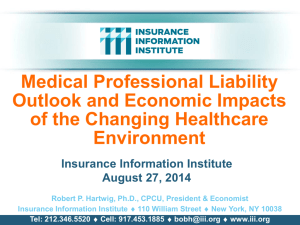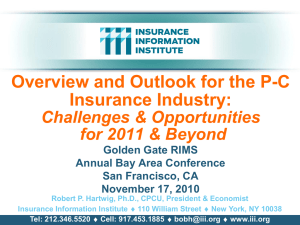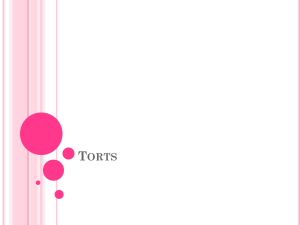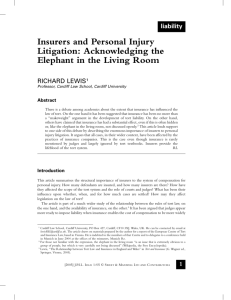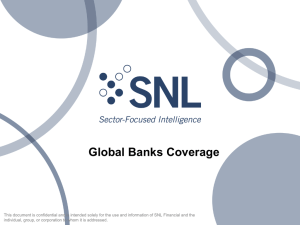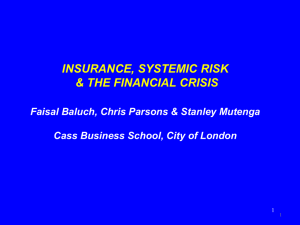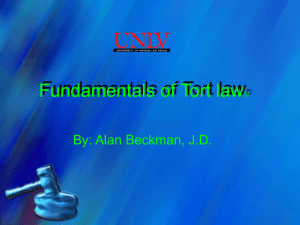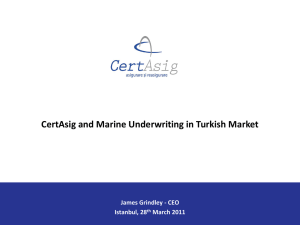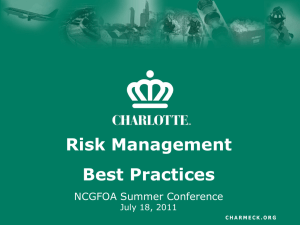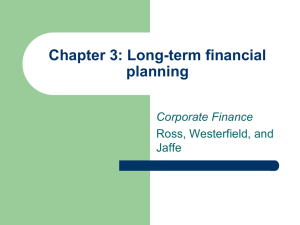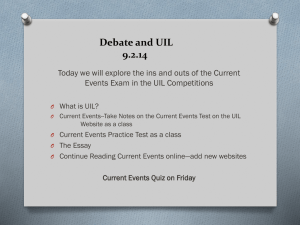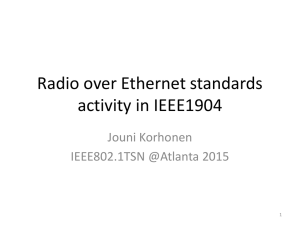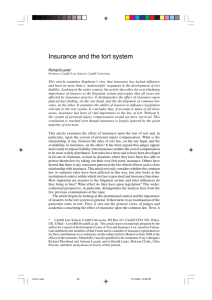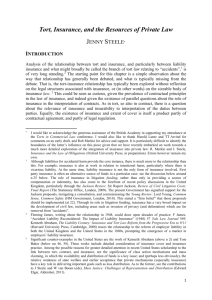Overview & Outlook for the P-C Insurance Industry
advertisement
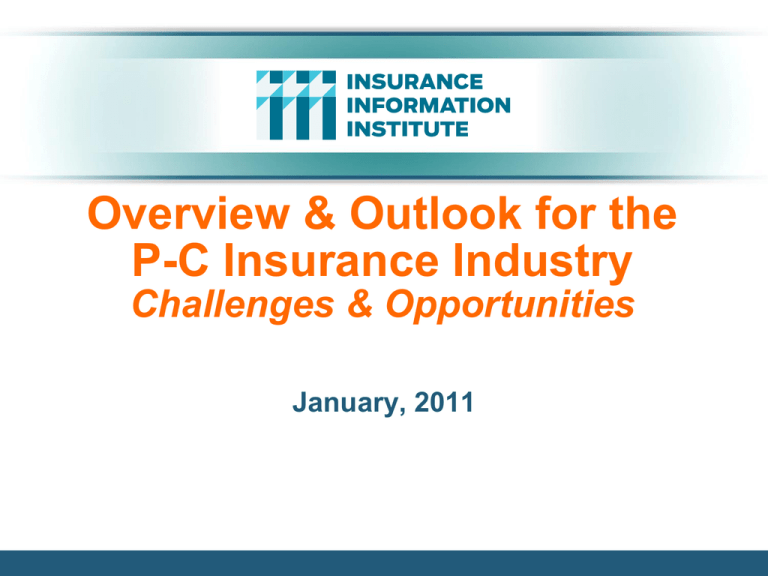
Overview & Outlook for the P-C Insurance Industry Challenges & Opportunities January, 2011 Reasons for Optimism, Causes for Concern in the P/C Insurance Industry Economic Recovery in US is Self-Sustaining: No Double Dip Recession Pessimism “Bubble” Persists; Negative Economic News Amplified; Positive News is Discounted Financial market volatility will remain a reality Era of Mass P/C Insurance Exposure Destruction Has Ended But restoration of destroyed exposure will take 3+ years in US No Secondary Spike in Unemployment or Swoon in Payrolls/WC Exposure But job and wage growth remains sluggish Exposure Growth Will Begin in 2nd Half 2010, Accelerate in 2011 Increase in Demand for Commercial Insurance is in its Earliest Stages and Will Accelerate in 2011 Includes workers comp, commercial auto, marine, many liability coverages, D&O Laggards: Property, inland marine, aviation Personal Lines: Auto leads, homeowners lags P/C Insurance Industry Will See Growth in 2011 for the First Time Since 2006 Investment Environment Is/Remains Much More Favorable Volatility, however, will persist and yields remain low Both are critical issues in long-tailed commercial lines like WC, Med Mal, D&O Source: Insurance Information Institute. 2 Reasons for Optimism, Causes for Concern in the P/C Insurance Industry P/C Insurance Industry Capacity as of 6/30/10 Is at Record Levels and Has Recovered 100%+ of the Capital Lost During the Financial Crisis As of 12/31/09 capacity was within 2% of pre-crisis high Record Capacity, Depressed Exposures Mean that Generally Soft Market Conditions Will Persist through 2010 and Potentially into 2011 There is No Catalyst for a Robust Hard Market at the Current Time High Global First Half 2010 CAT Losses Insufficient to Trigger Hard Market Localized insurance and reinsurance impacts are occurring, especially earthquake coverage in Latin/South America, Offshore Energy Markets, European Wind Cover Inflation Outlook for US and Major European Economies and Japan is Tame Will temper claims inflation Deflation is highly unlikely Financial Strength & Ratings of Global (Re)Insurance Industries Remained Strong Throughout the Financial Crisis in Sharp Contrast With Banks Insurers Avoided the Most Draconian Outcomes in Financial Services Reform Legislation Tort Environment in US is Beginning to Deteriorate; No Tort Reform in US Major Transformation of US Economy Underway with Major Opportunities for Insurers through 2020 in Health, Tech, Natural Resources, Energy Source: Insurance Information Institute. 3 Profitability Historically Volatile 4 $65,777 $16,531 $3,043 $28,311 $44,155 $38,501 $30,029 $20,559 $20,598 $10,870 $3,046 $10,000 $19,316 $20,000 $5,840 $30,000 $14,178 $40,000 $21,865 $50,000 $30,773 $60,000 2005 ROE*= 9.6% 2006 ROE = 12.7% 2007 ROE = 10.9% 2008 ROE = 0.3% 2009 ROAS1 = 5.8% 2010:H1 ROAS = 6.3% P-C Industry 2010:H1 profits rose $10.6B from $6.0B in 2009:H1, due mainly to $2.2B in realized capital gains vs. -$11.1B in previous realized capital losses $36,819 $70,000 $24,404 $80,000 $62,496 P/C Net Income After Taxes 1991–2010:H1 ($ Millions) $0 -$10,000 -$6,970 91 92 93 94 95 96 97 98 99 00 01 02 03 04 05 06 07 08 * ROE figures are GAAP; 1Return on avg. surplus. Excluding Mortgage & Financial Guaranty insurers yields a 7.5% ROAS for 2010:H1 and 4.6% for 2009. 2009:H1 net income was $19.2 billion and $10.2 billion in 2008:H1 excluding M&FG. Sources: A.M. Best, ISO, Insurance Information Institute 09 10:H1 ROE: P/C vs. All Industries 1987–2009* (Percent) P/C Profitability Is Cyclical and Volatile 20% Katrina, Rita, Wilma 15% 10% Sept. 11 Hugo 5% 4 Hurricanes Lowest CAT Losses in 15 Years Andrew 0% Northridge Financial Crisis* -5% 87 88 89 90 91 92 93 94 95 96 97 US P/C Insurers * Excludes Mortgage & Financial Guarantee in 2008 and 2009. Sources: ISO, Fortune; Insurance Information Institute. 98 99 00 01 02 03 04 05 06 07 08 09 All US Industries 6 ROE vs. Equity Cost of Capital: U.S. P/C Insurance:1991-2010:H1* (Percent) 18% 16% 6% 4% 2% 0% -9.0 pts -13.2 pts 8% +1.7 pts 10% -3.2 pts 12% -6.4 pts +2.3 pts 14% -2.9 pts The P/C Insurance Industry Well Short of Its Cost of Capital in 2008 but Narrowed the Gap in 2009 and 2010 The Cost of Capital is the Rate of Return Insurers Need to Attract and Retain Capital to the Business US P/C Insurers Missed Their Cost of Capital by an Average 6.7 Points from 1991 to 2002, but on Target or Better 2003-07, Fell Short in 2008-2010 -2% 91 92 93 94 95 96 97 98 99 ROE 00 01 02 03 04 05 06 07 08* 09* 10* Cost of Capital * Return on average surplus in 2008-2010 excluding mortgage and financial guaranty insurers. Source: The Geneva Association, Insurance Information Institute 7 A 100 Combined Ratio Isn’t What It Once Was: 90-95 Is Where It’s At Now A combined ratio of about 100 generated a 7% ROE in 2009, 10% in 2005 and 16% in 1979 Combined Ratio / ROE 110 105 15.9% 14.3% 100.6 100 100.1 97.5 100.7 12.7% 15% 101.0 99.5 100.1 7.3% 7.5% 12% 9.6% 95 18% 92.6 9% 8.9% 6% 90 4.4% 85 3% 0% 80 1978 1979 2003 2005 Combined Ratio 2006 2008* 2009* 2010:H1* ROE* Combined Ratios Must Be Lower in Today’s Depressed Investment Environment to Generate Risk Appropriate ROEs * 2009 and 2010:Q1 figures are return on average statutory surplus. 2008, 2009 and 2010:H1figures exclude mortgage and financial guaranty insurers Source: Insurance Information Institute from A.M. Best and ISO data. How P/C Insurance Industry Stability Has Benefitted Consumers Bottom Line: Insurance markets – unlike banking – are operating normally The basic function of insurance – the orderly transfer of risk from client to insurer – continues uninterrupted This means that insurers continue to: Pay claims (whereas 286 banks have gone under as of 9/3/10) – The promise is being fulfilled Renew existing policies (banks are reducing and eliminating lines of credit) Write new policies (banks are turning away people and businesses who want or need to borrow) Develop new products (banks are scaling back the products they offer) Compete intensively (banks are consolidating, reducing consumer choice) Source: Insurance Information Institute 11 Shifting Legal Liability & Tort Environment Is the Tort Pendulum Swinging Against Insurers? 14 Important Issues & Threats Facing Insurers: 2010–2015 Emerging Tort Threat No tort reform (or protection of recent reforms) is forthcoming from the current Congress or Administration Erosion of recent reforms is a certainty (already happening) Innumerable legislative initiatives will create opportunities to undermine existing reforms and develop new theories and channels of liability Torts twice the overall rate of inflation Influence personal and commercial lines, esp. auto liability Historically extremely costly to p/c insurance industry Leads to reserve deficiency, rate pressure Bottom Line: Tort “crisis” is on the horizon and will be recognized as such by 2012–2014 Source: Insurance Information Institute 15 Trial Bar Priorities Reverse U.S. Supreme Court decisions on pleadings Eliminate pre-dispute arbitration Erode federal preemption Expand securities litigation Source: Institute for Legal Reform. Confirm pro Pass Foreign trial lawyer Manufactures judges – Legal “Federalize Accountability Madison Act County” Grant Roll back enforcement existing authorities to legal reforms state AGs Over the Last Three Decades, Total Tort Costs* as a % of GDP Appear Somewhat Cyclical ($ Billions) $300 Tort Sytem Costs 2.50% Tort Costs as % of GDP $250 Tort System Costs $200 $150 2.00% $100 1.75% 2009–2010 Growth in Tort Costs as % of GDP is Due in Part to Shrinking GDP $50 $0 Tort Costs as % of GDP 2.25% 1.50% 80 82 84 86 88 90 92 94 96 98 00 02 04 06 08E 10E * Excludes the tobacco settlement, medical malpractice Sources: Tillinghast-Towers Perrin, 2008 Update on US Tort Cost Trends, Appendix 1A; I.I.I. calculations/estimates for 2009 and 2010 19 Business Leaders Ranking of Liability Systems in 2009* Worst States 41. New Mexico 42. Florida Nebraska 43. Montana 4. Indiana 44. Arkansas 5. Iowa 45. Illinois 6. Virginia 46. California Texas 47. Alabama South Carolina Hawaii 48. Mississippi 49. Louisiana Best States 1. Delaware 2. North Dakota 3. 7. Utah 8. Colorado 9. Massachusetts 10. South Dakota New in 2009 North Dakota Massachusetts South Dakota Drop-offs Maine Vermont Kansas Midwest/West has mix of good and bad states. Newly Notorious New Mexico Montana Arkansas Rising Above 50. West Virginia Source: US Chamber of Commerce 2009 State Liability Systems Ranking Study; Insurance Info. Institute. The Nation’s Judicial Hellholes: 2010 Illinois Watch List Cook County West Virginia New York City California Alabama Madison County, IL Jefferson County, MS Texas Gulf Coast Rio Grande Valley, TX Dishonorable Mention AR Supreme Court MN Supreme Court ND Supreme Court PA Governor MA Supreme Judicial Court Sacramento County New Jersey Atlantic County (Atlantic City) New Mexico Appellate Courts Source: American Tort Reform Association; Insurance Information Institute South Florida 21 Financial Strength & Ratings Industry Has Weathered the Storms Well 27 Reasons for US P/C Insurer Impairments, 1969–2008 Deficient Loss Reserves and Inadequate Pricing Are the Leading Cause of Insurer Impairments, Underscoring the Importance of Discipline. Investment Catastrophe Losses Play a Much Smaller Role Reinsurance Failure Sig. Change in Business 3.7% 4.2% Misc. 9.1% Investment Problems Affiliate Impairment 7.0% 38.1% Deficient Loss Reserves/ In-adequate Pricing 7.9% 7.6% Catastrophe Losses 8.1% Alleged Fraud 14.3% Rapid Growth Source: A.M. Best: 1969-2008 Impairment Review, Special Report, Apr. 6, 2009 29 P/C Premium Growth Primarily Driven by the Industry’s Underwriting Cycle, Not the Economy 30 Soft Market Appears to Persist in 2010 but May Be Easing: Relief in 2011? (Percent) 25% 1975-78 1984-87 2000-03 Net Written Premiums Fell 0.7% in 2007 (First Decline Since 1943) by 2.0% in 2008, and 4.2% in 2009, the First 3-Year Decline Since 1930-33. 20% 15% 10% 5% 0% 71 72 73 74 75 76 77 78 79 80 81 82 83 84 85 86 87 88 89 90 91 92 93 94 95 96 97 98 99 00 01 02 03 04 05 06 07 08 09 10F -5% NWP was flat with 0.0% growth in 10:H1 vs. -4.4% in 09:H1 Shaded areas denote “hard market” periods Sources: A.M. Best (historical and forecast), ISO, Insurance Information Institute. 31 Average Expenditures on Auto Insurance $950 $900 $878 $850 $830 $842 $831 $844 $816 $795 $786 $800 $750 $816 $726 $691 $700 $651 $705 $703 $668 $685 $690 $650 $600 94 95 96 97 98 99 00 01 02 03 04 05 06 07 08* 09* 10* Countrywide Auto Insurance Expenditures Increased 2.6% in 2008 and 3.5% Pace in 2009 (est.) and 4% in 2010 (est.) * Insurance Information Institute Estimates/Forecasts Source: NAIC, Insurance Information Institute estimates 2008-2010 based on CPI data. 32 Average Premium for Home Insurance Policies** $950 $879 $900 $850 $804 $800 $822 $835 $854 $764 $729 $750 $700 $668 $650 $593 $600 $550 $536 $508 $500 00 01 02 03 04 05 06 * Insurance Information Institute Estimates/Forecasts **Excludes state-run insurers. Source: NAIC, Insurance Information Institute estimates 2008-2010 based on CPI data. 07 08* 09* 10* 34 Average Commercial Rate Change, All Lines, (1Q:2004–2Q:2010) 1Q10 -5.3% 2Q10 4Q09 -5.6% -6.4% 3Q09 2Q09 -4.9% -5.8% 1Q09 -5.1% -6.4% -11.0% -12.9% -13.5% -12.0% -13.3% -11.8% -11.3% Source: Council of Insurance Agents & Brokers; Insurance Information Institute 4Q08 3Q08 2Q08 1Q08 4Q07 3Q07 2Q07 1Q07 4Q06 3Q06 -5.3% -3.0% -2.7% -4.6% KRW Effect -16% 2Q06 1Q06 4Q05 3Q05 2Q05 1Q05 4Q04 3Q04 2Q04 -14% Magnitude of Price Declines Shrank During Crisis, Reflecting Shrinking Capital, Reduced Investment Gains, Deteriorating Underwriting Performance, Higher Cat Losses and Costlier Reinsurance -9.6% -12% -8.2% -10% -9.7% -8% -9.4% -6% -7.0% -4% -5.9% -2% -3.2% 0% -0.1% 1Q04 (Percent) Market Remains Soft as Capital Restored and Underwriting Losses Remain Modest 35

